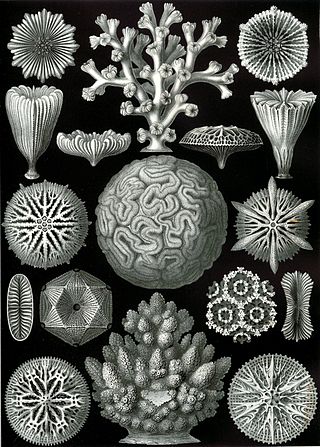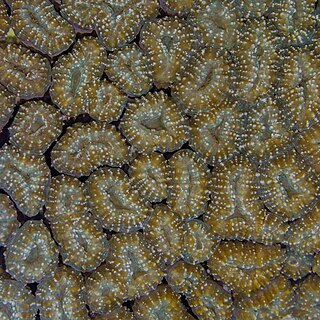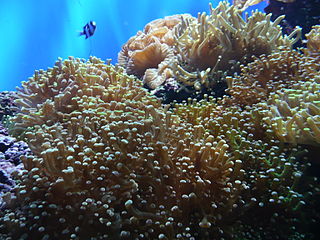
|} Corals are colonial marine invertebrates within the class Anthozoa of the phylum Cnidaria. They typically form compact colonies of many identical individual polyps. Coral species include the important reef builders that inhabit tropical oceans and secrete calcium carbonate to form a hard skeleton.

Anthozoa is a class of marine invertebrates which includes the sea anemones, stony corals and soft corals. Adult anthozoans are almost all attached to the seabed, while their larvae can disperse as part of the plankton. The basic unit of the adult is the polyp; this consists of a cylindrical column topped by a disc with a central mouth surrounded by tentacles. Sea anemones are mostly solitary, but the majority of corals are colonial, being formed by the budding of new polyps from an original, founding individual. Colonies are strengthened by calcium carbonate and other materials and take various massive, plate-like, bushy or leafy forms.

Scleractinia, also called stony corals or hard corals, are marine animals in the phylum Cnidaria that build themselves a hard skeleton. The individual animals are known as polyps and have a cylindrical body crowned by an oral disc in which a mouth is fringed with tentacles. Although some species are solitary, most are colonial. The founding polyp settles and starts to secrete calcium carbonate to protect its soft body. Solitary corals can be as much as 25 cm (10 in) across but in colonial species the polyps are usually only a few millimetres in diameter. These polyps reproduce asexually by budding, but remain attached to each other, forming a multi-polyp colony of clones with a common skeleton, which may be up to several metres in diameter or height according to species.

Porites astreoides, commonly known as mustard hill coral or yellow porites, is a colonial species of stony coral in the family Poritidae.

Tubastraea, also known as sun coral or sun polyps, is a genus of coral in the phylum Cnidaria. It is a cup coral in the family Dendrophylliidae.

Pavona duerdeni, the porkchop coral, is a coral that forms clusters of cream-colored lobes or discs. They grow in large colonies, divided into ridges or hillocks. The coral is considered to be uncommon due to its low confirmed abundance, yet they are more commonly found in Hawaii, the Indo-Pacific, and the Tropical Eastern Pacific. They make up some of the largest colonies of corals, and have a slow growth rate, as indicated by their dense skeletons. Their smooth appearance is due to their small corallites growing on their surface.

Montipora digitata, also known as finger coral, is a species of stony coral. It is found in shallow water in East Africa, the Indo-West Pacific, Kenya, Mozambique and Rodriguez.

Galaxea is a genus of colonial stony corals in the family Euphylliidae. Common names include crystal, galaxy, starburst and tooth coral. They are abundant on reefs in the Indo-Pacific region and the Red Sea. They are found in water less than 20 metres (66 ft) deep and favour turbid sites. They are sometimes kept in reef aquaria.

Porites lobata, known by the common name lobe coral, is a species of stony coral in the family Poritidae. It is found growing on coral reefs in tropical parts of the Indian and Pacific Oceans.

Millepora alcicornis, or sea ginger, is a species of colonial fire coral with a calcareous skeleton. It is found on shallow water coral reefs in the tropical west Atlantic Ocean. It shows a variety of different morphologies depending on its location. It feeds on plankton and derives part of its energy requirements from microalgae found within its tissues. It is an important member of the reef building community and subject to the same threats as other corals. It can cause painful stings to unwary divers.

Siderastrea radians, also known as the lesser starlet coral or the shallow-water starlet coral, is a stony coral in the family Siderastreidae. It is found in shallow parts of the western Atlantic Ocean as small, solid mounds or encrusting sheets.

Scolymia lacera, the fleshy disk coral, is a species of stony coral in the family Mussidae. It occurs on reefs in shallow waters in the Caribbean Sea, the Gulf of Mexico, the Bahamas, Bermuda and southern Florida.

Lobophyllia corymbosa, also known as lobed cactus coral or brain root coral, is a species of large polyp stony coral in the family Lobophylliidae. It occurs on reefs in shallow waters in the Red Sea, off the coast of East Africa, and in other parts of the tropical Indo-Pacific.

Cynarina lacrymalis is a species of stony coral in the family Lobophylliidae. It is variously known as the flat cup coral, solitary cup coral, button coral, doughnut coral, or cat's eye coral. It is found in the western Indo-Pacific Ocean and is sometimes kept in reef aquaria.

Coelastrea aspera is a species of stony coral in the family Merulinidae. It is a colonial species native to the Indo-Pacific region where it occurs in shallow water. It was first described by the American zoologist Addison Emery Verrill in 1866 as Goniastrea aspera but it has since been determined that it should be in a different genus and its scientific name has been changed to Coelastrea aspera. This is a common species throughout much of its wide range and the International Union for Conservation of Nature has rated its conservation status as being of "least concern".

Blastomussa wellsi is a species of large polyp stony coral. It is unclear in which family the genus Blastomussa belongs. This coral is found in the west and central Indo-Pacific region.

Porites cylindrica, commonly known as Hump coral, is a stony coral belonging to the subclass Hexacorallia in the class Anthozoa. Hexacorallia differ from other subclasses in that they have 6 or fewer axes of symmetry. Members of this class possess colonial polyps which can be reef-building, secreting a calcium carbonate skeleton. They are dominant in both inshore reefs and midshelf reefs.

Euphylliidae are known as a family of polyped stony corals under the order Scleractinia.


















